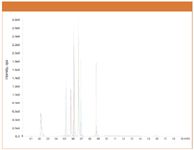Analyzing the SAMHSA Drug Panel on Kinetex Core-Shell Media
Urine is often used to analyze drugs of abuse because it is easy to collect and is available in copious amounts.
Jeremy Bierman and Carl Sanchez, Phenomenex, Inc.
Urine is often used to analyze drugs of abuse because it is easy to collect and is available in copious amounts. However, it can be challenging to analyze urine samples due to the variances in the endogenous nature of the matrix, which can impact the chromatographic separation and quantitation. A high-throughput SPE plus LC–MS method using core-shell UHPLC columns to screen for a panel of 11 drugs of abuse (Substance Abuse and Mental Health Service Administration, SAMHSA) was developed using Kinetex core-shell media. This new high-throughput method demonstrates the power of new-generation HPLC media, as well as considerations when developing methods for LC–MS analysis.
Materials and Methods
Urine samples from five different lots were hydrolyzed to convert the glucuronide metabolites to native form using β-glucuronidase. Hydrolyzed samples were then adjusted to a pH of 5.95 with 100 mM ammonium acetate buffer. SPE cleanup was performed using Strata™-X-C, a high cation exchange capacity polymeric material, in a 30 mg/3 mL tube. Analysis of the 11 compounds was done using an Agilent® 1200SL HPLC coupled with an Applied Biosystems® 4000 QTRAP® (with Turbo V™ ion source) at different concentrations on a Kinetex® 2.6 µm C18 50 x 2.1 mm core-shell column. A gradient separation method was used with an aqueous mobile phase of 0.1% formic acid in water (A) and organic mobile phase of acetonitrile (B). The gradient used was from 5% to 95% B in 1.7 min followed with a 0.2 min hold at 95% B and re-equilibration at initial conditions for a total cycle time of 2.6 min. The flow rate was 1.2 mL/ min and the column oven was set at 25 °C.
Results and Conclusion
The analysis of 11 drugs of abuse at cut-off concentrations was completed in less than 2 min (Figure 1). The use of the new Kinetex core-shell HPLC column technology provided extremely sharp chromatographic peaks with average peak width of 1–2 s at the base. Because of the narrow peak width for each analyte, a timed acquisition program for the MS was used to achieve accurate peak quantitation. The analytical method resulted in accuracies between 85–99% for all analytes at the LLOQ. At LLOQ and 3 x LLOQ all RSDs were below 15%, indicating a wide linear working range for all compounds. The Strata-X-C SPE protocol has been optimized for the 11 analytes and the internal standards. Endogenous contaminants with low pKa values were not retained which allowed for a 100% methanol wash to more effectively remove contaminants, such as uronilin which can interfere with LC–MS analysis.

Figure 1: LCâMS-MS analysis of 11 drugs of abuse compounds ran on core-shell Kinetex C18 columns. Note the good resolution and narrow peaks for most compounds. The high performance column allowed for analysis of the SAMHSA panel in under 2 min.
The combination of an extremely targeted and consistent sample preparation method and the highly efficient Kinetex column yielded a significant increase in productivity and throughput while solvent usage and analysis time were minimized. Core-shell media utilizes optimized particle geometry to generate high efficiency separations on par with sub-2 µm UHPLC columns except with much lower back pressures. Key to maximizing performance on older HPLC's is to match detector acquisition rate with core-shell Kinetex column performance. High efficiencies close to 300,000 plates per meter for Kinetex core-shell HPLC columns can result in peak widths as narrow as 1 s in width. The method for analyzing the SAMHSA panel on Kinetex 2.6µ core shell media is sensitive and accurate and a significant improvement over existing GC–MS or LC–MS methods using standard HPLC columns.

Phenomenex, Inc.
411 Madrid Ave., Torrance, CA 90501
tel. (310) 212-0555; (310) 328-7768
Website: www.phenomenex.com

The Benefits of Custom Bonded Silica
April 1st 2025Not all chromatography resins are created equal. Off-the-shelf chromatography resins might not always meet the rigorous purification requirements of biopharmaceutical manufacturing. Custom bonded silica from Grace can address a wide range of separation challenges, leading to real performance improvements. Discover more about the latest innovations in chromatography silica from Grace, including VYDAC® and DAVISIL®.
5 Things to Consider When Selecting a Chromatography Silica
April 1st 2025Particularly in the pharmaceutical industry, drug purity isn’t just a goal – it’s essential for achieving safety, stability and efficacy. However, purification is easier said than done, especially with challenging molecules like DNA and RNA “oligonucleotides,” due in large part to their diversity and the range of impurities that can be generated during production. Enter DAVISIL® chromatographic silica, with a wide range of pore diameters and particle sizes to meet your specific application, performance and sustainability requirements. Before you choose the chromatography resin for your next purification application, take a look at these 5 considerations.
Automating Protein Purification: Efficiency, Yield, and Reproducibility
March 27th 2025Recent advancements in automated protein purification stress the importance of efficiency, scalability, and yield consistency. This eBook compares different purification platforms, highlighting their impact on downstream applications and demonstrating how automation enhances throughput and process control.
MilliporeSigma: Ultrapure Water for Sensitive LC-MS Analysis of Pesticides
March 25th 2025The aim of the study was to illustrate the efficiency of Milli-Q® water purification systems in eliminating pesticides from tap water, thereby producing and delivering reliable and consistent-quality ultrapure water suitable for pesticides analysis















